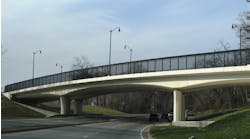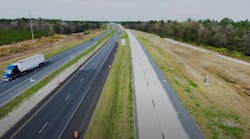As part of FHWA’s Innovative Bridge Research and Deployment (IBRD) project, self-consolidating concrete (SCC) was used during the replacement of the Stalnaker Run Bridge, a rural bridge located along old U.S. Rte. 219 outside Elkins, W. Va.
This construction marked the first time that SCC was ever used for a West Virginia Department of Transportation (WVDOT) construction project. The construction plan for the bridge replacement included diverting traffic to a temporary bridge while the old bridge was demolished and replaced by a two-lane, 44.5-ft-long span semi-integral abutment bridge that extends over a small stream. SCC was used for cast-in-place caisson elements of the substructure and precast/prestressed box-beam elements of the superstructure with traditional concrete being used to cast identical elements for the sake of comparing performances.
There were many barriers to implementing a newer technology such as SCC for full-scale construction. Since this was the first application of SCC for WVDOT use, it meant that many of the contractors, concrete suppliers and field engineers for this project would have very limited experience in dealing with SCC prior to construction. No existing WVDOT specifications existed for the use of SCC, so special provisions were included in the construction plans that outlined the mix qualification, acceptance testing and general placement requirements for each SCC mix. These provisions were written in such a manner as to prevent intentional or inadvertent disqualification of any potential contractors or suppliers. It also was imperative that technical support from admixture suppliers, West Virginia University (WVU) researchers and WVDOT officials was available for the contractors and concrete suppliers throughout the project.
A few alterations
The caissons for the Stalnaker Run Bridge were designed to consist of a 3.5-ft diam., 6-ft-deep drilled shaft overlying an integral 3-ft diam., 12-ft-deep rock socket. Both of the bridge’s abutments were supported by three caissons; an SCC caisson mix was used for the three caissons of Abutment 1, while a traditional caisson mix was used for those of Abutment 2. Both types of caisson concrete had design strengths of 4,500 psi.
The special provisions that were written for the caisson SCC did not vary significantly from WVDOT requirements for hardened property testing of traditional concrete. Alterations did exist with regards to the fresh property testing that is specific to SCC and limitations on the mix proportions. Although requirements for mix qualification were somewhat more limiting, fresh properties of the SCC for site acceptance had to demonstrate a slump-flow of 21 in. ± 2 in. (per ASTM C1611), a J-Ring Value of 1.5 in. or less (per ASTM C1621) and an air content of 6% ± 1.5% (per ASTM C231). Material limitations were similar to those of traditional concrete, except limitations were placed on the maximum size of coarse aggregate (3?4 in.), the cement content (< eight 94-lb “bags”) and the ratio of the weight of fine aggregate to total aggregate (<0.50).
The mix design for the caisson SCC was done in cooperation between the selected ready-mix producer, their admixture supplier and WVU researchers. Per the request of the supplier, a single coarse-aggregate gradation was used for the caisson SCC mix design, although it is quite common to include an intermediate gradation for densification of SCC. The mix proportions for the final approved SCC mix included 750 lb/cu yd of total cementitious materials with a 15% replacement of cement with Class F fly ash, a water-to-cementitious materials ratio (w/cm) of 0.38 and a fine-aggregate-to-total-aggregate ratio of 0.50.
The caissons for Abutment 1 were successfully constructed using SCC on July 16, 2009, while the caissons for Abutment 2 were cast a week later on July 23—each eventually becoming an integral part of its respective abutment. As anticipated, all six caissons were placed into water-filled holes using tremie placement techniques. Field specimens taken from the site indicated that all concrete delivered to the site exceeded the 28-day, 4,500-psi compressive strength requirement.
A little less time
A total of five prestressed box beams were required for the Stalnaker Run Bridge. These had outer dimensions of 4 ft wide by 17 in. deep and included a total of 29 ½-in. oversized prestressing strands. Concrete design requirements for the beams included compressive strengths of 6,000 psi at the time of detensioning and 8,000 psi at 28 days.
The special provisions for the prestressed SCC included similar tests for site acceptance as those for the caisson SCC. For use in beam fabrication, the SCC had to demonstrate a slump-flow within 2 in. of the manufacturer’s specified target (maximum of 25 in.), a J-Ring Value of 1.5 in. or less and an air content of 5% ± 1%. Material limitations were similar to those of traditional concrete, except limitations were placed on the maximum size of coarse aggregate (3?4 in.) and the ratio of the weight of fine aggregate to total aggregate (<0.50). However, the qualification requirements were more rigorous to ensure a durable bridge superstructure is produced, and included tests for freeze-thaw durability, rapid chloride permeability and bond strength among others.
The mix design for the prestressed SCC was done primarily by the box-beam fabricator with the assistance of their admixture supplier. Three precast/prestressed box beams were fabricated using the traditional vibrated concrete (TVC) mix design, and three PC box beams were fabricated using the prestressed SCC mix. All three TVC box beams were eventually incorporated into the Stalnaker Run Bridge, as well as two of the three SCC box beams; the third SCC box beam was delivered to WVU laboratories for testing. Specimens taken from select batches during fabrication indicated that the 28-day, 8,000-psi compressive strength requirement was met. Both sets of beams, as well as all test specimens, were steam-cured in the casting bed until a compressive strength of 6,000 psi was observed, at which time the tendons were released.
There was a significant reduction in time to cast the SCC box beams in comparison to the TVC beams; it took less than three hours to cast three beams using SCC as opposed to well over six hours to place an identical quantity of TVC. Moreover, fewer men were required to place the SCC.
The primary reason that SCC led to a reduction in placement times in this application is that the self-compacting ability of SCC allowed for an adjustment in the construction procedures. When using SCC for this application, it was possible to place all of the reinforcement as well as the void prior to casting, so placement was done in just one step without the need for any vibration or compaction.
It was noted that the SCC beams had not achieved the required 6,000-psi compressive strength after the first night of steam curing, so these were required to undergo an additional day of curing prior to detensioning. This type of setback could be avoided by making appropriate adjustments to the mix design, such as slightly lowering the water-to-cementitious materials ratio in order to ensure adequate early strength.
The precast box beams were placed on the Stalnaker Run Bridge on Oct. 5, 2009. Over the next month, the bridge deck and the remaining non-structural elements were placed. The Stalnaker Run Bridge re-opened to traffic by early November. WVU researchers installed an on-site monitoring station and continue to collect strain and temperature data from the SCC caissons and both types of box beams. They also continue to monitor the performance of WVDOT’s first bridge that utilized SCC technology.


